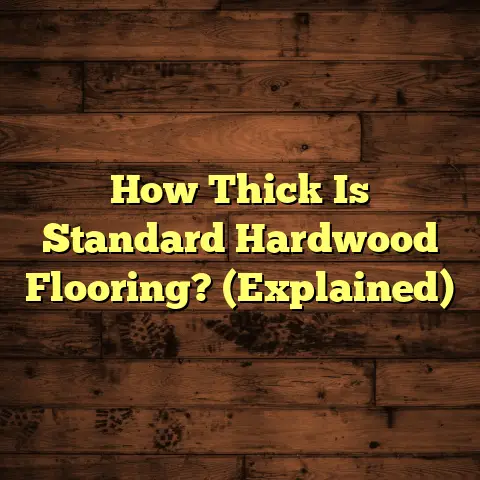Hardwood Floors: Install Cost? (5-Bid Breakdown!)
They’re not just a surface; they’re a statement, a foundation for memories, and a timeless addition to any home.
Introduction: Blending Styles
with Hardwood Floors
Have you ever walked into a room and instantly felt a sense of warmth and elegance? Chances are, it was the hardwood floors.
The beauty of hardwood is its versatility. Whether your style is rustic farmhouse, sleek modern, or classic traditional, hardwood can adapt and enhance the overall aesthetic.
Think about a wide-plank oak floor in a cozy living room, paired with a roaring fireplace and plush furniture.
Or imagine a glossy, dark-stained maple floor in a contemporary apartment, reflecting the city lights and adding a touch of sophistication.
The options are endless, and the key is to find the right wood type, finish, and installation method that complements your existing decor and reflects your personal style.
I’ve seen firsthand how the right flooring choice can completely transform a space, adding value, character, and a touch of “wow” factor.
So, let’s dive into the world of hardwood and explore how to make the best flooring decisions for your home.
Section 1: Understanding
Hardwood Flooring
Okay, let’s get down to brass tacks. What exactly is hardwood flooring?
Essentially, it’s flooring made from a single piece of wood, harvested from deciduous trees (trees that lose their leaves annually).
Think oak, maple, cherry, hickory – these are your classic hardwood species.
Varieties of Hardwood
Each type of wood has its own unique grain pattern, color variation, and hardness level.
-
Oak: The most popular choice, known for its durability and versatility. Red oak has a pinkish tone, while white oak is more neutral.
-
Maple: A lighter, more uniform grain, perfect for modern spaces. It’s also very durable.
-
Cherry: A rich, reddish-brown hue that adds warmth and elegance. It’s a bit softer than oak or maple.
-
Hickory: The hardest of the bunch, with a bold grain pattern and rustic appeal.
Characteristics of Hardwood Floors
Hardwood floors are prized for their durability, longevity, and timeless beauty.
With proper care and maintenance, they can last for generations.
I’ve walked into homes with original hardwood floors that are over a century old, and they still look amazing!
However, hardwood does require some TLC. Regular sweeping and mopping are essential, and you’ll want to avoid excessive moisture and scratches.
Solid vs. Engineered Hardwood
Now, here’s where things get a little more technical: solid hardwood vs. engineered hardwood.
-
Solid Hardwood: This is the real deal – a single piece of wood, milled from a tree. It can be sanded and refinished multiple times, making it a long-lasting investment. However, it’s more susceptible to moisture and temperature changes, so it’s not ideal for basements or bathrooms.
-
Engineered Hardwood: This consists of a thin layer of hardwood veneer bonded to a core of plywood or high-density fiberboard (HDF). It’s more dimensionally stable than solid hardwood, meaning it’s less likely to warp or cup in humid environments. It can also be installed over concrete slabs, making it a versatile option for various applications.
Pros and Cons:
| Feature | Solid Hardwood | Engineered Hardwood |
|---|---|---|
| Durability | Excellent (can be refinished multiple times) | Good (can be refinished, but fewer times) |
| Moisture Resistance | Poor (susceptible to warping) | Good (more stable in humid environments) |
| Cost | Higher | Lower to mid-range |
| Installation | More complex, often requires professional installation | Easier to install, can be DIY |
| Lifespan | 50-100+ years | 20-50 years |
Section 2: The Cost of Hardwood
Floor Installation
Alright, let’s talk money. How much does it really cost to install hardwood floors?
The answer, unfortunately, is “it depends.” Several factors influence the final price, including:
-
Type of Hardwood Chosen: Exotic species like Brazilian cherry or teak will cost significantly more than domestic options like oak or maple.
-
Size of the Area to be Covered: Obviously, a larger room will require more materials and labor, increasing the overall cost.
-
Complexity of the Installation: Intricate patterns like herringbone or parquet will require more time and skill, driving up the labor costs. Also, if the subfloor isn’t level, it needs to be leveled first, which adds to the cost.
-
Geographic Location and Market Rates: Labor costs can vary significantly depending on where you live. Big cities tend to have higher rates than rural areas.
Here’s a general idea of the cost breakdown:
-
Materials (Hardwood Flooring): \$5 – \$15+ per square foot
-
Labor (Installation): \$3 – \$8+ per square foot
-
Subfloor Preparation: \$1 – \$3 per square foot (if needed)
-
Removal of Old Flooring: \$1 – \$3 per square foot (if needed)
Total Estimated Cost: \$9 – \$29+ per square foot
So, for a 200-square-foot room, you could be looking at anywhere from \$1,800 to \$5,800 or more.
I know, it’s a wide range, but that’s why it’s so important to get multiple bids.
Section 3: The 5-Bid Breakdown
Okay, so you’re ready to get some quotes. Smart move! Getting multiple bids is the best way to ensure you’re getting a fair price and the best possible service.
I always recommend getting at least three bids, but for this article, I’m going to break down five different scenarios to give you a comprehensive overview.
Let’s dive into those bids!
Bid 1: Local Contractor A
I’ve worked with Local Contractor A on several projects, and they have a solid reputation in the community.
They specialize in hardwood flooring and have been in business for over 15 years.
-
Type of Hardwood Proposed: ¾” Solid Red Oak, pre-finished with a satin polyurethane coating.
-
Labor Costs: \$6 per square foot, including installation, trimming, and baseboard installation.
-
Estimated Time for Completion: 3-4 days for a 200-square-foot room.
-
Included Services: Removal of old carpet, subfloor inspection, minor subfloor leveling (up to ¼” variation), and disposal of debris.
-
Warranty and Aftercare Services: 1-year warranty on labor, manufacturer’s warranty on materials. They also offer a free consultation on maintenance and cleaning products.
Total Estimated Cost (200 sq ft):
- Materials (\$8/sq ft x 200 sq ft): \$1,600
- Labor (\$6/sq ft x 200 sq ft): \$1,200
- Removal of old carpet (\$1.5/sq ft x 200 sq ft): \$300
- Total: \$3,100
Bid 2: Local Contractor B
Local Contractor B is another reputable company in the area, but they’re a bit smaller than Contractor A. They tend to focus on higher-end projects and custom installations.
-
Type of Hardwood Proposed: ½” Engineered White Oak, with a wire-brushed texture and a matte oil finish.
-
Labor Costs: \$7 per square foot, including installation, trimming, and baseboard installation.
-
Estimated Time for Completion: 4-5 days for a 200-square-foot room.
-
Included Services: Removal of old carpet, detailed subfloor preparation (including leveling and patching), and custom stain matching if desired.
-
Warranty and Aftercare Services: 2-year warranty on labor, manufacturer’s warranty on materials. They also offer a complimentary cleaning kit and a follow-up inspection after 6 months.
Total Estimated Cost (200 sq ft):
- Materials (\$10/sq ft x 200 sq ft): \$2,000
- Labor (\$7/sq ft x 200 sq ft): \$1,400
- Removal of old carpet (\$1.5/sq ft x 200 sq ft): \$300
- Total: \$3,700
Bid 3: National Flooring Chain
National Flooring Chain is a big box store that offers a wide range of flooring options and installation services.
They often have competitive prices, but the quality of installation can vary depending on the installer they subcontract.
-
Type of Hardwood Proposed: ¾” Solid Oak (generic brand), pre-finished with a glossy polyurethane coating.
-
Labor Costs: \$4 per square foot, including installation and basic trimming.
-
Estimated Time for Completion: 5-7 days for a 200-square-foot room.
-
Included Services: Removal of old carpet (for an additional fee), basic subfloor inspection.
-
Warranty and Aftercare Services: 1-year warranty on labor, manufacturer’s warranty on materials. They also offer financing options.
Total Estimated Cost (200 sq ft):
- Materials (\$6/sq ft x 200 sq ft): \$1,200
- Labor (\$4/sq ft x 200 sq ft): \$800
- Removal of old carpet (\$2/sq ft x 200 sq ft): \$400
- Total: \$2,400
Bid 4: Independent Installer C
Independent Installer C is a solo operator with years of experience. They often offer more personalized service and can be more flexible with pricing.
-
Type of Hardwood Proposed: Reclaimed Hardwood Flooring, with a natural oil finish.
-
Labor Costs: \$5 per square foot, including installation and basic trimming.
-
Estimated Time for Completion: 7-10 days for a 200-square-foot room.
-
Included Services: Removal of old carpet, basic subfloor inspection.
-
Warranty and Aftercare Services: 1-year warranty on labor.
Total Estimated Cost (200 sq ft):
- Materials (\$12/sq ft x 200 sq ft): \$2,400
- Labor (\$5/sq ft x 200 sq ft): \$1,000
- Removal of old carpet (\$1.5/sq ft x 200 sq ft): \$300
- Total: \$3,700
Bid 5: DIY Installation Costs
Taking the DIY route can save you money on labor costs, but it requires time, effort, and some serious DIY skills.
-
Type of Hardwood Proposed: ¾” Solid Oak, pre-finished with a satin polyurethane coating.
-
Tools and Materials Required:
- Flooring nailer/stapler: \$200 – \$400
- Miter saw: \$150 – \$300
- Underlayment: \$0.50 – \$1 per square foot
- Moisture meter: \$50 – \$100
- Safety Glasses & Gloves: \$20
- Mallet and Tapping Block: \$30 – \$50
- Total: \$450 – \$870
-
Estimated Time Investment: 20-40 hours for a 200-square-foot room (depending on experience).
Total Estimated Cost (200 sq ft):
- Materials (\$8/sq ft x 200 sq ft): \$1,600
- Tools: \$450-\$870
- Total: \$2,050 – \$2,470
Section 4: Comparing the Bids
Okay, we’ve got all the bids laid out. Now, let’s compare them side-by-side to see which one comes out on top.
| Feature | Contractor A | Contractor B | National Chain | Independent C | DIY |
|---|---|---|---|---|---|
| Wood Type | Solid Oak | Eng. Oak | Solid Oak | Reclaimed | Solid Oak |
| Material Cost/sq ft | \$8 | \$10 | \$6 | \$12 | \$8 |
| Labor Cost/sq ft | \$6 | \$7 | \$4 | \$5 | \$0 |
| Total Cost (200 sq ft) | \$3,100 | \$3,700 | \$2,400 | \$3,700 | \$2,050-2470 |
| Warranty | 1 year | 2 years | 1 year | 1 year | N/A |
| Included Services | Basic | Detailed | Basic | Basic | N/A |
| Estimated Time | 3-4 days | 4-5 days | 5-7 days | 7-10 days | 20-40 hrs |
Pros and Cons of Each Option:
-
Contractor A: A good balance of price and quality. Solid wood is a plus, but the warranty is shorter than Contractor B.
-
Contractor B: Higher price, but you get engineered wood (better for moisture), a longer warranty, and more detailed subfloor prep.
-
National Chain: Lowest price, but the quality of materials and installation may be questionable.
-
Independent C: Similar price to Contractor B, but you get a more unique reclaimed wood look.
-
DIY: Cheapest option upfront, but requires time, effort, and skill. No warranty on labor.
How to Evaluate Bids:
When evaluating bids, consider the following:
-
Your Budget: How much are you willing to spend on your flooring project?
-
Your Needs: Do you need a durable floor for a high-traffic area? Or are you looking for a specific aesthetic?
-
Your Skill Level (for DIY): Are you confident in your ability to install hardwood flooring correctly?
-
The Contractor’s Reputation: Check online reviews and ask for references.
Section 5: Conclusion
Choosing the right hardwood floor and installer can feel overwhelming, but by understanding the various costs involved and obtaining multiple bids, you can make an informed decision that fits your budget, needs, and style.
Don’t be afraid to ask questions, negotiate prices, and do your research.
Next Steps:
-
Schedule Consultations: Meet with contractors in person to discuss your project and get a feel for their expertise.
-
Visit Showrooms: See different types of hardwood flooring firsthand to get a better idea of what you like.
-
Read Reviews: Check online reviews and ask for references to ensure you’re hiring a reputable contractor.
I hope this article has been helpful in your hardwood flooring journey. Happy flooring!





